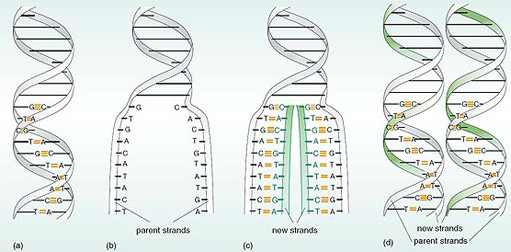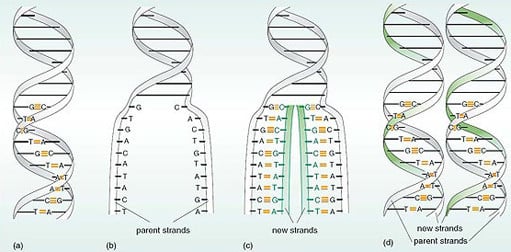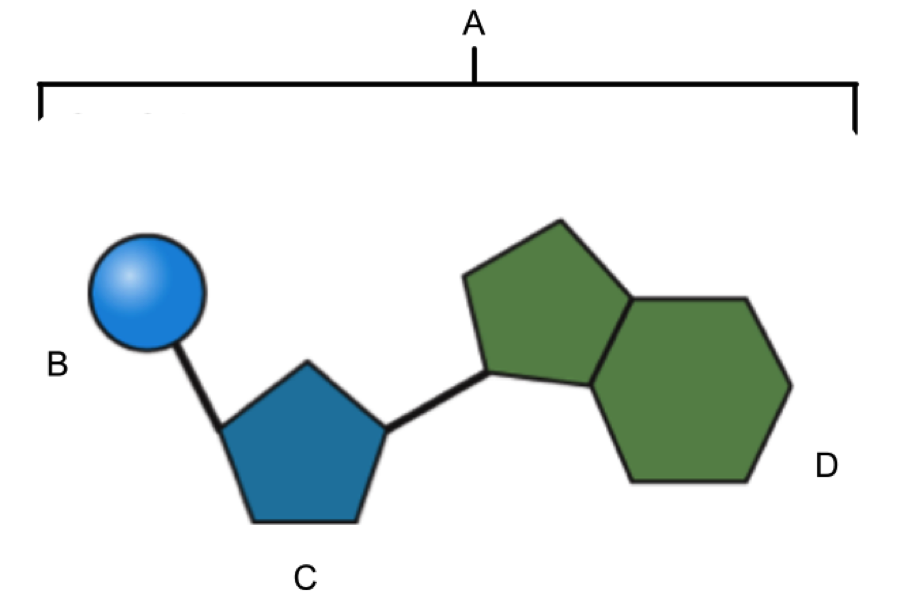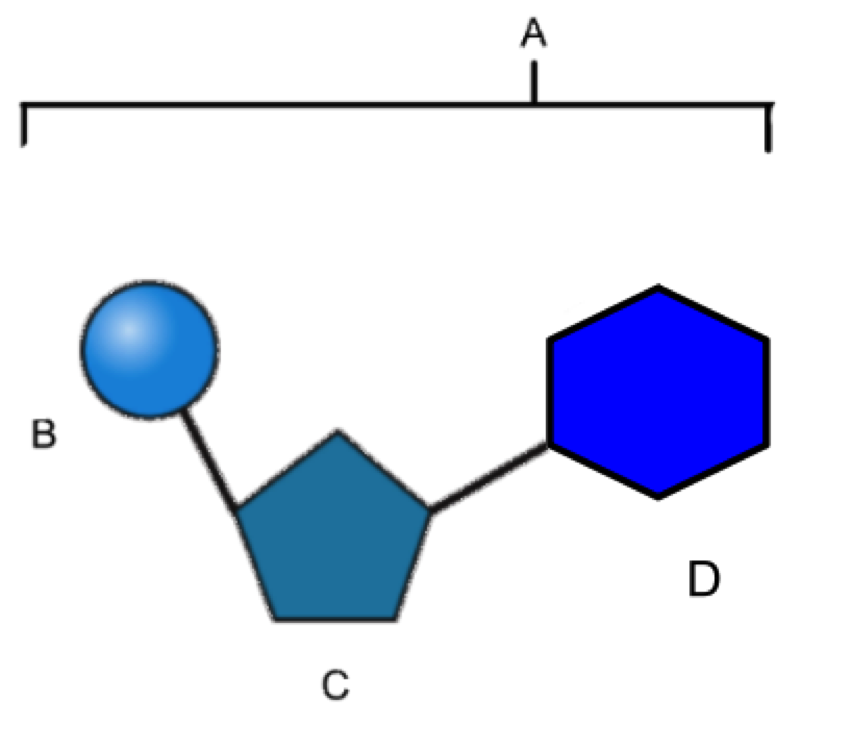Bio 1 - Unit 6b - Central Dogma

- 1.
Which of the following is a pair of complementary bases?
- A.
Cytosine and cytosine
- B.
Thymine and adenine
- C.
Adenine and guanine
- D.
Thymine and ctyosine
Correct Answer
B. Thymine and adenineExplanation
Thymine and adenine are a pair of complementary bases because they form a base pair in DNA. Adenine always pairs with thymine, and thymine always pairs with adenine through hydrogen bonding. This complementary base pairing is essential for the stability and replication of DNA.Rate this question:
-
- 2.
In a DNA molecule, which molecules make up the sides of the double helix?
- A.
Single nucleotides
- B.
Pairs of nucleotides
- C.
Joined sugars and phosphates
- D.
Joined nitrogenous bases and phosphates
Correct Answer
C. Joined sugars and phosphatesExplanation
The sides of the DNA double helix are made up of joined sugars and phosphates. The sugar-phosphate backbone forms a continuous chain along the length of the DNA molecule, with the sugars and phosphates alternating. This backbone provides structural support for the DNA molecule and helps to stabilize the double helix structure. The nitrogenous bases, on the other hand, are found in the interior of the helix and form the base pairs that hold the two strands of DNA together.Rate this question:
-
- 3.
If one strand of a DNA molecule reads TATCGAT, what does the complementary strand of DNA read?
- A.
GCGATCG
- B.
ATAGCTA
- C.
CGCATCG
- D.
ATAGCAT
Correct Answer
B. ATAGCTAExplanation
The complementary strand of DNA reads ATAGCTA. This is because in DNA, the bases pair up in a specific way - adenine (A) pairs with thymine (T), and cytosine (C) pairs with guanine (G). Therefore, the complementary strand will have adenine (A) where the original strand had thymine (T), thymine (T) where the original strand had adenine (A), cytosine (C) where the original strand had guanine (G), and guanine (G) where the original strand had cytosine (C).Rate this question:
-
- 4.
Which of the following statements about DNA and RNA is true?
- A.
RNA is arranged in a double helix.
- B.
The kinds of sugar in the nucleotides of DNA and RNA differ.
- C.
DNA contains nitrogenous bases and phosphates, while RNA does not.
- D.
DNA contains uracil, while RNA contains thymine.
Correct Answer
B. The kinds of sugar in the nucleotides of DNA and RNA differ.Explanation
The correct answer is that the kinds of sugar in the nucleotides of DNA and RNA differ. DNA is composed of deoxyribose sugar, while RNA is composed of ribose sugar. This difference in sugar composition is one of the key distinctions between DNA and RNA. DNA contains nitrogenous bases and phosphates, while RNA does not, and RNA contains uracil, while DNA contains thymine. However, the statement that RNA is arranged in a double helix is incorrect, as RNA is typically single-stranded.Rate this question:
-
- 5.
Which DNA sequence produced an mRNA strand with the sequence AGUACA?
- A.
UCAUGU
- B.
TCATGT
- C.
GUACAG
- D.
CAGTAC
Correct Answer
B. TCATGTExplanation
The mRNA strand is complementary to the DNA sequence, so to find the DNA sequence that produces the given mRNA sequence AGUACA, we need to find the DNA sequence that is complementary to AGUACA. In this case, the complementary sequence is UCAUGU, so the DNA sequence that produces the mRNA strand AGUACA is TCATGT.Rate this question:
-
- 6.
Transcription creates an mRNA molecule using DNA as a template. Where does this occur?
- A.
Outside the cell
- B.
In the cytoplasm
- C.
In the nucleus
- D.
In the ribosomes
Correct Answer
C. In the nucleusExplanation
Transcription is the process of synthesizing mRNA using DNA as a template. This process occurs in the nucleus of a cell. The DNA molecule is unwound and one of its strands is used as a template to create a complementary mRNA molecule. The mRNA molecule is then transported out of the nucleus and into the cytoplasm, where it can be translated into a protein by ribosomes. Therefore, the correct answer is "in the nucleus."Rate this question:
-
- 7.
The sequence of a strand of mRNA is GCAUUGUAA. If the sequence includes a stop codon, how many amino acids does this code for? (STOP is not an amino acid)
- A.
2
- B.
3
- C.
6
- D.
9
Correct Answer
A. 2Explanation
The given mRNA sequence GCAUUGUAA does not contain any stop codon, which is a sequence that signals the termination of protein synthesis. Therefore, the sequence codes for a complete protein without any premature termination. Since there is no stop codon present, the mRNA sequence will code for a single amino acid sequence. Hence, the correct answer is 2.Rate this question:
-
- 8.
What process is illustrated in the diagram?
- A.
Replication
- B.
Transcription
- C.
Translation
- D.
Mutation
Correct Answer
A. ReplicationExplanation
The correct answer is replication. Replication is the process by which DNA molecules are copied to produce two identical DNA molecules. In the given diagram, it is likely that the process being depicted is the replication of DNA, as it involves the synthesis of a new DNA strand based on the existing template strand. Transcription is the process of synthesizing RNA from DNA, translation is the process of synthesizing proteins from RNA, and mutation refers to a change in the DNA sequence.Rate this question:
-
- 9.
Ribosomes are made of ___.
- A.
RRNA and two protein subunits
- B.
TRNA and mRNA
- C.
RRNA and mRNA
- D.
Protein and tRNA
Correct Answer
A. RRNA and two protein subunitsExplanation
Ribosomes are cellular structures responsible for protein synthesis. They are composed of ribosomal RNA (rRNA) and two protein subunits. The rRNA provides the structural framework for the ribosome, while the protein subunits help in catalyzing the formation of peptide bonds between amino acids during protein synthesis. Therefore, the correct answer is rRNA and two protein subunits.Rate this question:
-
- 10.
Watson and Crick, with the help of Rosalind Franklin, were the first to suggest that DNA is ___.
- A.
A short molecule
- B.
A protein molecule
- C.
The shape of a double helix
- D.
The genetic material
Correct Answer
C. The shape of a double helixExplanation
Watson and Crick, with the assistance of Rosalind Franklin, proposed that DNA is the shape of a double helix. This means that DNA is structured as two strands that are twisted around each other in a spiral shape. This discovery was groundbreaking because it provided a clear understanding of how genetic information is stored and transmitted in living organisms. The double helix structure of DNA has since become a fundamental concept in biology.Rate this question:
-
- 11.
Messenger RNA (mRNA) is formed in the process of ___.
- A.
Transcription
- B.
Translation
- C.
Replication
- D.
Mutation
Correct Answer
A. TranscriptionExplanation
Messenger RNA (mRNA) is formed in the process of transcription. Transcription is the process in which the DNA sequence in a gene is copied into mRNA. This process occurs in the nucleus of a cell and involves the enzyme RNA polymerase binding to the DNA and synthesizing a complementary mRNA strand. The mRNA molecule then carries the genetic information from the DNA to the ribosomes in the cytoplasm, where it is used as a template for protein synthesis in the process of translation. Replication is the process of copying DNA, mutation refers to changes in the DNA sequence, and neither of these processes directly result in the formation of mRNA.Rate this question:
-
- 12.
The process by which a DNA molecule is copied is ___.
- A.
Transcription
- B.
Translation
- C.
Replication
- D.
Mutation
Correct Answer
C. ReplicationExplanation
Replication is the correct answer because it refers to the process in which a DNA molecule is copied or duplicated. During replication, the DNA strands separate and new complementary strands are synthesized, resulting in two identical DNA molecules. This process is essential for cell division and the transmission of genetic information from one generation to the next. Transcription, on the other hand, is the process of synthesizing RNA from a DNA template, while translation is the process of synthesizing proteins from RNA. Mutation refers to a change in the DNA sequence, which can occur during replication or other processes.Rate this question:
-
- 13.
Each set of three nucleotides on mRNA coding for an amino acid is referred to as a(n) ___.
- A.
Codon
- B.
Anticodon
- C.
Ribosome
- D.
Base pair
Correct Answer
A. CodonExplanation
A set of three nucleotides on mRNA that codes for an amino acid is called a codon. Codons are the basic units of the genetic code and determine the sequence of amino acids in a protein. Each codon corresponds to a specific amino acid or a stop signal, and the order of codons determines the order of amino acids in a protein. Anticodons are found on tRNA molecules and are complementary to codons, allowing tRNA to bring the correct amino acid to the ribosome during protein synthesis. Ribosomes are the cellular structures where protein synthesis occurs. Base pairs are the complementary nucleotide pairs that make up DNA and RNA molecules.Rate this question:
-
- 14.
The nucleotide triplet on tRNA that complements a codon is called a(n) ___.
- A.
Codon
- B.
Anticodon
- C.
Ribosome
- D.
Base pair
Correct Answer
B. AnticodonExplanation
The nucleotide triplet on tRNA that complements a codon is called an anticodon. The anticodon is located on the tRNA molecule and is responsible for recognizing and binding to the corresponding codon on the mRNA during translation. This complementary base pairing between the anticodon and codon ensures the accurate translation of the genetic code into a specific amino acid sequence.Rate this question:
-
- 15.
Adenine is to thymine as guanine is to ___.
- A.
Uracil
- B.
Cytosine
- C.
Adenine
- D.
Thymine
Correct Answer
B. CytosineExplanation
Adenine and thymine are complementary base pairs in DNA, while guanine and cytosine are also complementary base pairs. This means that in DNA, adenine always pairs with thymine and guanine always pairs with cytosine. Therefore, the correct answer is cytosine.Rate this question:
-
- 16.
DNA is to RNA as double strand is to ___.
- A.
Single strand
- B.
Ribose
- C.
Triple strand
- D.
Double helix
Correct Answer
A. Single strandExplanation
DNA and RNA are both types of nucleic acids that play a crucial role in genetic information storage and transfer. DNA is a double-stranded molecule, consisting of two strands that are complementary to each other and held together by hydrogen bonds. Similarly, RNA is a single-stranded molecule, with a structure that is derived from one of the strands of DNA. Therefore, the analogy between DNA and RNA can be understood as the relationship between a double strand and a single strand.Rate this question:
-
- 17.
Transcription is to mRNA as translation is to ___.
- A.
Protein
- B.
Codon
- C.
TRNA
- D.
DNA
Correct Answer
A. ProteinExplanation
Transcription is the process of synthesizing messenger RNA (mRNA) from DNA. Similarly, translation is the process of synthesizing a protein using the information encoded in mRNA. Therefore, the correct answer is protein.Rate this question:
-
- 18.
What is the molecule labeled A?
- A.
Nucleotide
- B.
Phosphate group
- C.
Ribose sugar
- D.
Nitrogen base
Correct Answer
A. NucleotideExplanation
The molecule labeled A is a nucleotide. A nucleotide is composed of three components: a phosphate group, a sugar molecule (ribose or deoxyribose), and a nitrogenous base. In this case, the molecule labeled A represents a nucleotide as it contains all three components.Rate this question:
-
- 19.
What is the component labeled B?
- A.
Nucleotide
- B.
Phosphate group
- C.
Ribose sugar
- D.
Nitrogen base
Correct Answer
B. Phosphate groupExplanation
Component B is labeled as a phosphate group. A phosphate group consists of a phosphorus atom bonded to four oxygen atoms. In the context of nucleotides, the phosphate group is one of the three components along with a nitrogen base and a sugar molecule. It plays a crucial role in the structure and function of nucleotides, as it forms the backbone of DNA and RNA molecules through phosphodiester bonds. The phosphate group also carries a negative charge, which contributes to the overall negative charge of nucleic acids.Rate this question:
-
- 20.
If this molecule is found in DNA, then structure C would be called ___.
- A.
Ribose sugar
- B.
Phosphate group
- C.
Deoxyribose sugar
- D.
Nitrogen base
Correct Answer
C. Deoxyribose sugarExplanation
If the molecule is found in DNA, it means that the DNA is made up of deoxyribose sugar. Deoxyribose sugar is a component of DNA and is responsible for forming the backbone of the DNA molecule. It is a modified form of ribose sugar, with one oxygen atom removed, hence the prefix "deoxy". The presence of deoxyribose sugar in the structure C indicates that it is a DNA molecule.Rate this question:
-
- 21.
If this molecule is found in RNA, then structure C would be called ___.
- A.
Ribose sugar
- B.
Phosphate group
- C.
Deoxyribose sugar
- D.
Nitrogen base
Correct Answer
A. Ribose sugarExplanation
If the molecule is found in RNA, then it would contain ribose sugar. Ribose sugar is a component of RNA, whereas deoxyribose sugar is a component of DNA. The phosphate group and nitrogen base are also present in both RNA and DNA. Therefore, the correct answer is ribose sugar.Rate this question:
-
- 22.
The structure labeled D is a(n) ___.
- A.
Ribose sugar
- B.
Phosphate group
- C.
Deoxyribose sugar
- D.
Nitrogen base
Correct Answer
D. Nitrogen baseExplanation
The structure labeled D in the question is referred to as a nitrogen base. Nitrogen bases are one of the four components that make up the building blocks of DNA and RNA. They are responsible for the genetic coding and play a crucial role in determining the genetic information. The other options mentioned in the question, such as ribose sugar, phosphate group, and deoxyribose sugar, are also important components of DNA and RNA but they do not represent the structure labeled D. Therefore, the correct answer is nitrogen base.Rate this question:
-
- 23.
The number of rings in the nitrogen base indicates that this molecule is classified as a(n) ___.
- A.
Pyrimidine
- B.
Alanine compound
- C.
Purine
- D.
Tangerine
Correct Answer
C. PurineExplanation
The number of rings in the nitrogen base indicates that this molecule is classified as a purine. Purines are nitrogenous bases that consist of two rings, while pyrimidines have only one ring. Alanine compound and tangerine are not relevant to the classification of the molecule.Rate this question:
-
- 24.
The number of rings in the nitrogen base indicates that this molecule is classified as a(n) ___.
- A.
Pyrimidine
- B.
Alanine compound
- C.
Purine
- D.
Tangerine
Correct Answer
A. PyrimidineExplanation
The number of rings in the nitrogen base indicates that this molecule is classified as a pyrimidine. Pyrimidines are a type of nitrogenous base found in DNA and RNA molecules. They have a single ring structure, which distinguishes them from purines, which have a double ring structure. Alanine compound and tangerine are unrelated to the classification of the molecule based on the number of rings in the nitrogen base.Rate this question:
-
- 25.
Translate the following mRNA code. What is the amino acid sequence? GGUCGAUGGUGGCCCACCAGAGAUGAGUUAA
- A.
Met - Val - Ala - His - Gln - Arg
- B.
Gly - Arg - Trp - Trp - Pro - Thr - Arg - Met - Ser
- C.
Met - Pro - Ala - His - Trp - Trp - Ser
- D.
Gly - Arg - Trp - Pro - Met - Val - Arg
Correct Answer
A. Met - Val - Ala - His - Gln - ArgExplanation
The given mRNA code GGUCGAUGGUGGCCCACCAGAGAUGAGUUAA translates to the amino acid sequence Met - Val - Ala - His - Gln - Arg.Rate this question:
-
- 26.
The nucleotide that is found in RNA but not DNA is ___.
- A.
Uracil
- B.
Cytosine
- C.
Adenine
- D.
Thymine
Correct Answer
A. UracilExplanation
RNA and DNA are both nucleic acids, but they differ in their nucleotide composition. DNA contains the nucleotides adenine (A), cytosine (C), guanine (G), and thymine (T), while RNA contains adenine (A), cytosine (C), guanine (G), and uracil (U). Therefore, the correct answer is uracil, as it is the nucleotide that is found in RNA but not DNA.Rate this question:
-
- 27.
The nucleotide that is found in DNA but not RNA is ___.
- A.
Uracil
- B.
Cytosine
- C.
Adenine
- D.
Thymine
Correct Answer
D. ThymineExplanation
Thymine is the correct answer because it is a nucleotide that is specifically found in DNA and not in RNA. In DNA, thymine pairs with adenine through hydrogen bonds, while in RNA, uracil replaces thymine and pairs with adenine. Therefore, thymine is unique to DNA and distinguishes it from RNA.Rate this question:
-
Quiz Review Timeline +
Our quizzes are rigorously reviewed, monitored and continuously updated by our expert board to maintain accuracy, relevance, and timeliness.
-
Current Version
-
Mar 21, 2023Quiz Edited by
ProProfs Editorial Team -
Dec 06, 2013Quiz Created by
Christopher Mack
- Aeronautics Quizzes
- Aerospace Quizzes
- Agricultural Science Quizzes
- Astrology Quizzes
- Astronomy Quizzes
- Atom Quizzes
- Biochemistry Quizzes
- Biomechanics Quizzes
- Biostatistics Quizzes
- Biotechnology Quizzes
- Botany Quizzes
- Branches Of Science Quizzes
- Chemistry Quizzes
- Cytology Quizzes
- Easy Science Quizzes
- Ecology Quizzes
- Electrical Quizzes
- Embryology Quizzes
- Endocrinology Quizzes
- Engineering Quizzes
- Environmental Science Quizzes
- Epidemiology Quizzes
- Experiment Quizzes
- Forestry Quizzes
- Fossil Quizzes
- Gas Quizzes
- General Science Quizzes
- Genetics Quizzes
- Histology Quizzes
- Human Biology Quizzes
- Integrated Science Quizzes
- Invention Quizzes
- Library Science Quizzes
- Lighting Quizzes
- Liquid Quizzes
- Marine Biology Quizzes
- Microbiology Quizzes
- Molecular Biology Quizzes
- Nature Quizzes
- Neuroscience Quizzes
- Nuclear Science Quizzes
- Oceanography Quizzes
- Physics Quizzes
- Psychology Quizzes
- Science And Technology Quizzes
- Science Glossary Quizzes
- Science Knowledge Quizzes
- Science Practice Quizzes
- Scientific Method Quizzes
- Scientific Notation Quizzes
- Soil Science Quizzes
- Solar System Quizzes
- Solid Quizzes
- Zoology Quizzes
 Back to top
Back to top





